Financial Statements: Analyzing Business Performance & Accounting
VerifiedAdded on 2023/06/17
|11
|3396
|379
Report
AI Summary
This report provides an analysis of business performance, focusing on the determinants of performance from both macro and microeconomic perspectives, using XYZ Plc as a case study. It explains the role of accounting in decision-making and financial reporting within an organization, differentiating between financial statements such as the balance sheet and income statement, and clarifying the terms used within them. The report includes a calculation and interpretation of key financial ratios for XYZ Plc for the years 2019 and 2020, including Return on Shareholder's Equity, Return on Capital Employed, Operating Profit Margin, Current Ratio, and Earnings per Share. Finally, it defines management accounting and its importance for planning, control, and decision-making within a company, highlighting its contribution to organizational growth.

Business Finance and
Economics
Economics
Paraphrase This Document
Need a fresh take? Get an instant paraphrase of this document with our AI Paraphraser
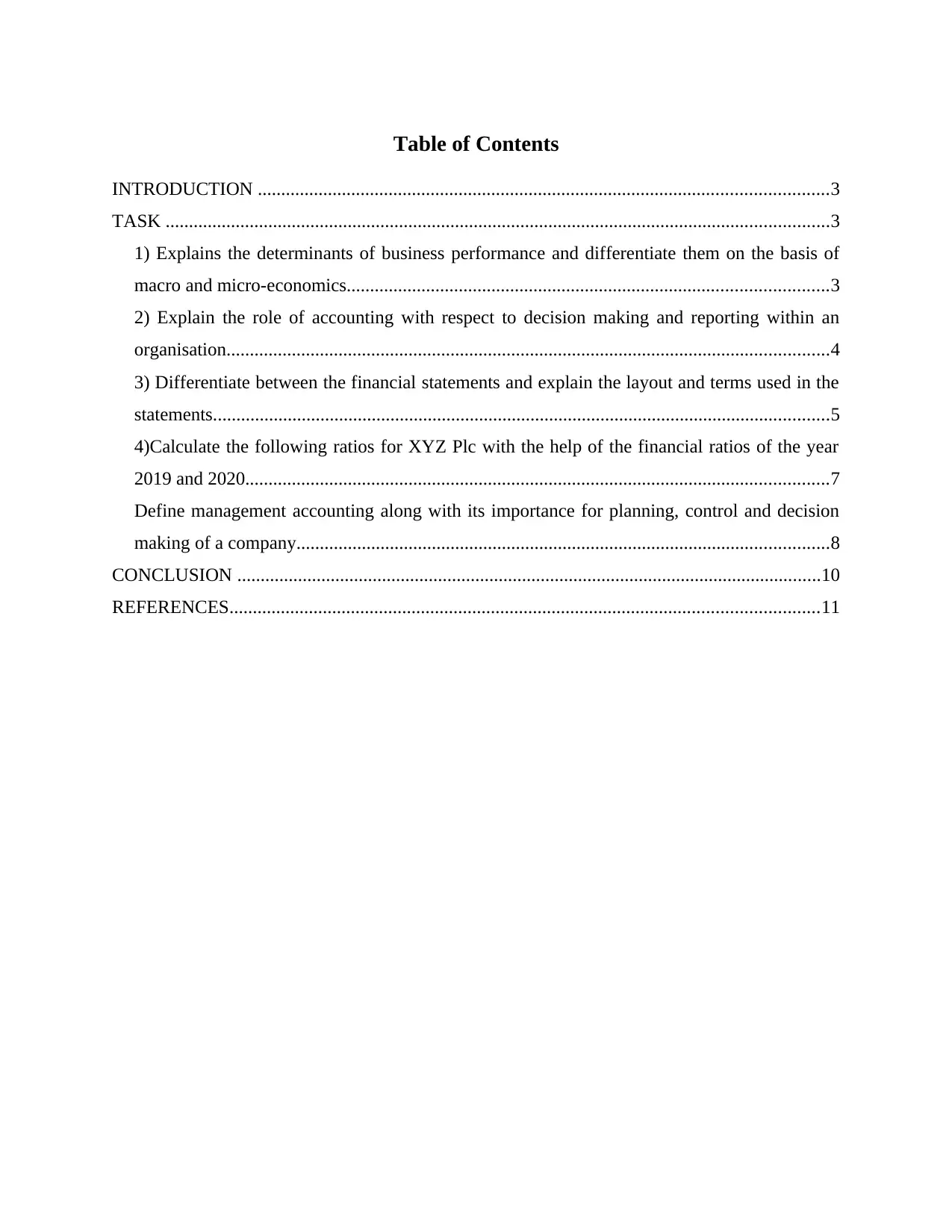
Table of Contents
INTRODUCTION ..........................................................................................................................3
TASK ..............................................................................................................................................3
1) Explains the determinants of business performance and differentiate them on the basis of
macro and micro-economics.......................................................................................................3
2) Explain the role of accounting with respect to decision making and reporting within an
organisation.................................................................................................................................4
3) Differentiate between the financial statements and explain the layout and terms used in the
statements....................................................................................................................................5
4)Calculate the following ratios for XYZ Plc with the help of the financial ratios of the year
2019 and 2020.............................................................................................................................7
Define management accounting along with its importance for planning, control and decision
making of a company..................................................................................................................8
CONCLUSION .............................................................................................................................10
REFERENCES..............................................................................................................................11
INTRODUCTION ..........................................................................................................................3
TASK ..............................................................................................................................................3
1) Explains the determinants of business performance and differentiate them on the basis of
macro and micro-economics.......................................................................................................3
2) Explain the role of accounting with respect to decision making and reporting within an
organisation.................................................................................................................................4
3) Differentiate between the financial statements and explain the layout and terms used in the
statements....................................................................................................................................5
4)Calculate the following ratios for XYZ Plc with the help of the financial ratios of the year
2019 and 2020.............................................................................................................................7
Define management accounting along with its importance for planning, control and decision
making of a company..................................................................................................................8
CONCLUSION .............................................................................................................................10
REFERENCES..............................................................................................................................11
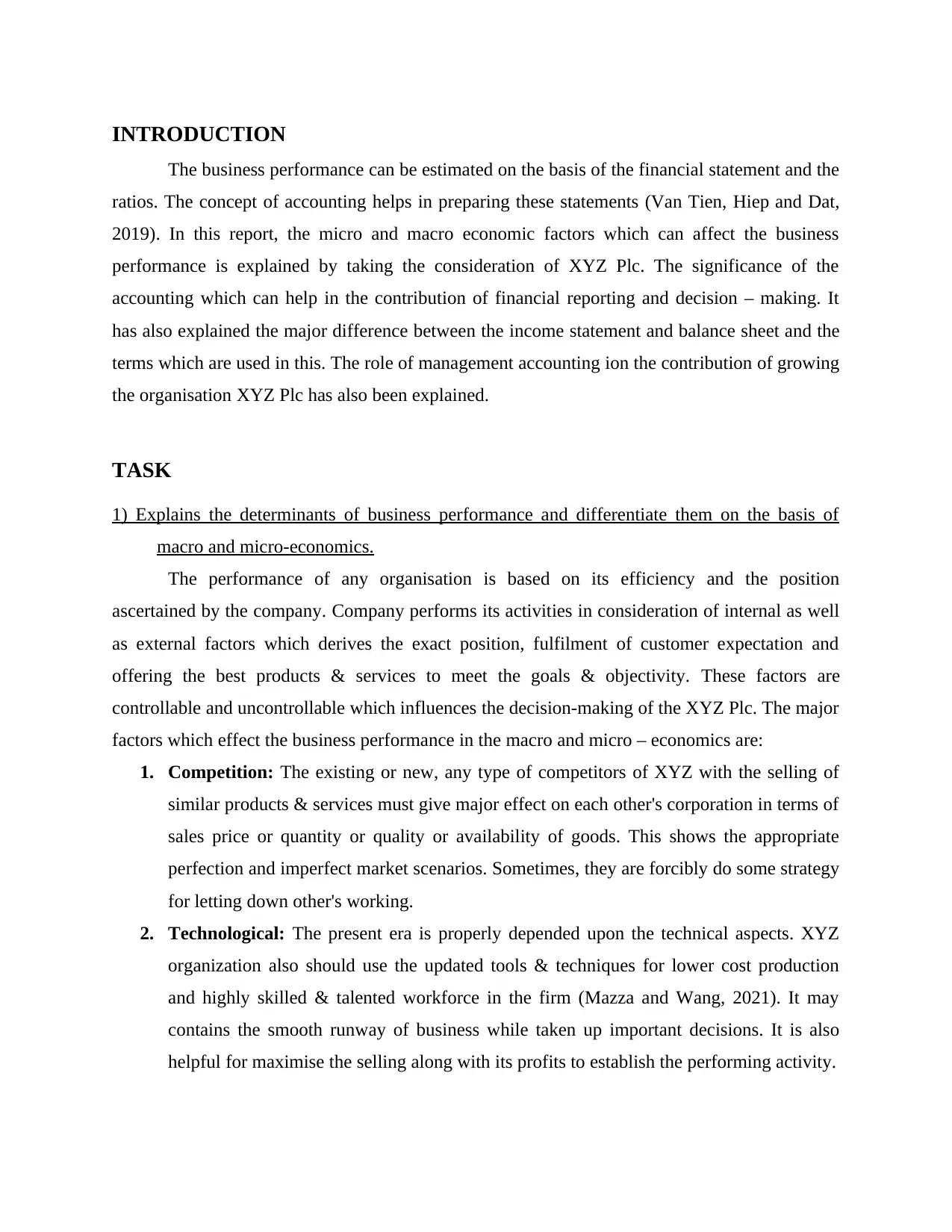
INTRODUCTION
The business performance can be estimated on the basis of the financial statement and the
ratios. The concept of accounting helps in preparing these statements (Van Tien, Hiep and Dat,
2019). In this report, the micro and macro economic factors which can affect the business
performance is explained by taking the consideration of XYZ Plc. The significance of the
accounting which can help in the contribution of financial reporting and decision – making. It
has also explained the major difference between the income statement and balance sheet and the
terms which are used in this. The role of management accounting ion the contribution of growing
the organisation XYZ Plc has also been explained.
TASK
1) Explains the determinants of business performance and differentiate them on the basis of
macro and micro-economics.
The performance of any organisation is based on its efficiency and the position
ascertained by the company. Company performs its activities in consideration of internal as well
as external factors which derives the exact position, fulfilment of customer expectation and
offering the best products & services to meet the goals & objectivity. These factors are
controllable and uncontrollable which influences the decision-making of the XYZ Plc. The major
factors which effect the business performance in the macro and micro – economics are:
1. Competition: The existing or new, any type of competitors of XYZ with the selling of
similar products & services must give major effect on each other's corporation in terms of
sales price or quantity or quality or availability of goods. This shows the appropriate
perfection and imperfect market scenarios. Sometimes, they are forcibly do some strategy
for letting down other's working.
2. Technological: The present era is properly depended upon the technical aspects. XYZ
organization also should use the updated tools & techniques for lower cost production
and highly skilled & talented workforce in the firm (Mazza and Wang, 2021). It may
contains the smooth runway of business while taken up important decisions. It is also
helpful for maximise the selling along with its profits to establish the performing activity.
The business performance can be estimated on the basis of the financial statement and the
ratios. The concept of accounting helps in preparing these statements (Van Tien, Hiep and Dat,
2019). In this report, the micro and macro economic factors which can affect the business
performance is explained by taking the consideration of XYZ Plc. The significance of the
accounting which can help in the contribution of financial reporting and decision – making. It
has also explained the major difference between the income statement and balance sheet and the
terms which are used in this. The role of management accounting ion the contribution of growing
the organisation XYZ Plc has also been explained.
TASK
1) Explains the determinants of business performance and differentiate them on the basis of
macro and micro-economics.
The performance of any organisation is based on its efficiency and the position
ascertained by the company. Company performs its activities in consideration of internal as well
as external factors which derives the exact position, fulfilment of customer expectation and
offering the best products & services to meet the goals & objectivity. These factors are
controllable and uncontrollable which influences the decision-making of the XYZ Plc. The major
factors which effect the business performance in the macro and micro – economics are:
1. Competition: The existing or new, any type of competitors of XYZ with the selling of
similar products & services must give major effect on each other's corporation in terms of
sales price or quantity or quality or availability of goods. This shows the appropriate
perfection and imperfect market scenarios. Sometimes, they are forcibly do some strategy
for letting down other's working.
2. Technological: The present era is properly depended upon the technical aspects. XYZ
organization also should use the updated tools & techniques for lower cost production
and highly skilled & talented workforce in the firm (Mazza and Wang, 2021). It may
contains the smooth runway of business while taken up important decisions. It is also
helpful for maximise the selling along with its profits to establish the performing activity.
⊘ This is a preview!⊘
Do you want full access?
Subscribe today to unlock all pages.

Trusted by 1+ million students worldwide
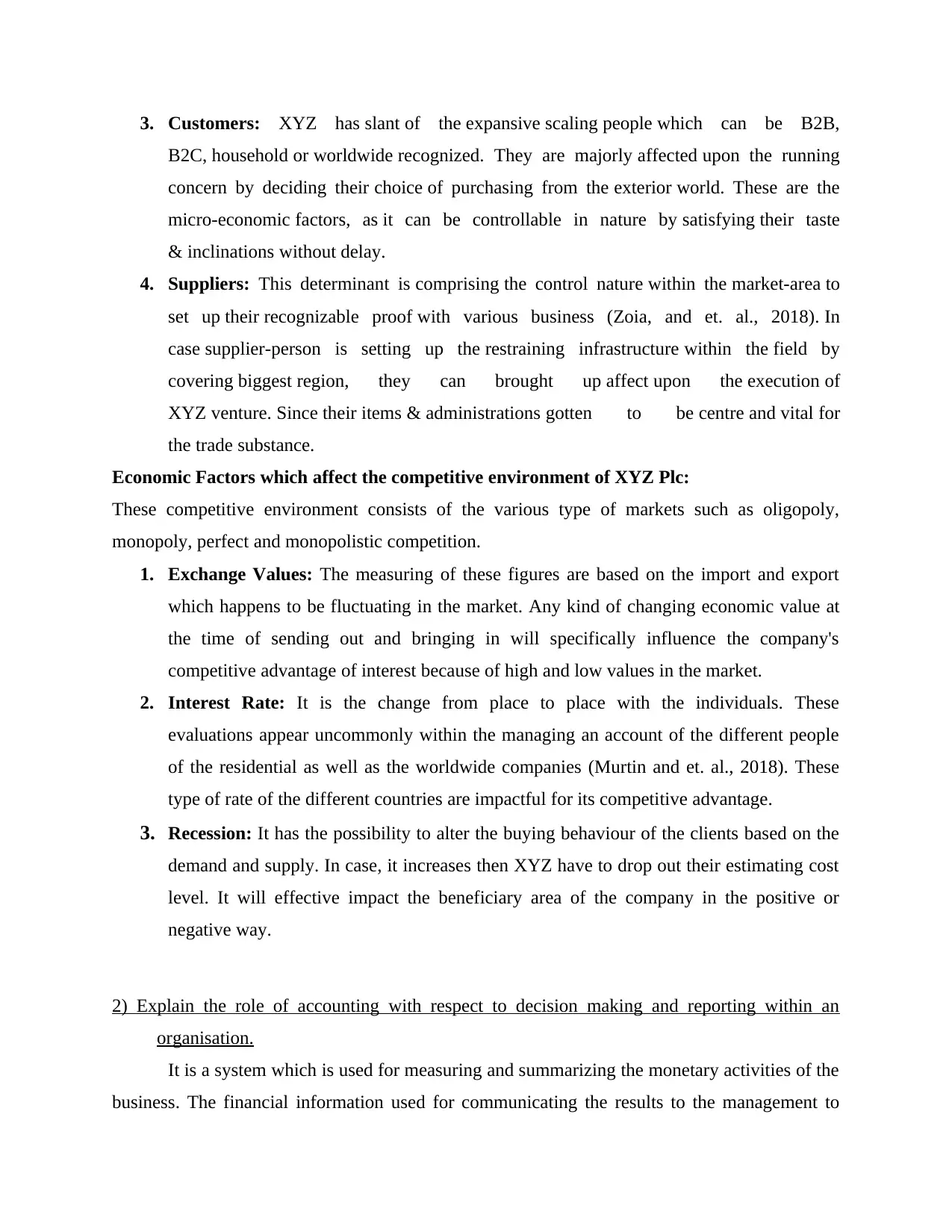
3. Customers: XYZ has slant of the expansive scaling people which can be B2B,
B2C, household or worldwide recognized. They are majorly affected upon the running
concern by deciding their choice of purchasing from the exterior world. These are the
micro-economic factors, as it can be controllable in nature by satisfying their taste
& inclinations without delay.
4. Suppliers: This determinant is comprising the control nature within the market-area to
set up their recognizable proof with various business (Zoia, and et. al., 2018). In
case supplier-person is setting up the restraining infrastructure within the field by
covering biggest region, they can brought up affect upon the execution of
XYZ venture. Since their items & administrations gotten to be centre and vital for
the trade substance.
Economic Factors which affect the competitive environment of XYZ Plc:
These competitive environment consists of the various type of markets such as oligopoly,
monopoly, perfect and monopolistic competition.
1. Exchange Values: The measuring of these figures are based on the import and export
which happens to be fluctuating in the market. Any kind of changing economic value at
the time of sending out and bringing in will specifically influence the company's
competitive advantage of interest because of high and low values in the market.
2. Interest Rate: It is the change from place to place with the individuals. These
evaluations appear uncommonly within the managing an account of the different people
of the residential as well as the worldwide companies (Murtin and et. al., 2018). These
type of rate of the different countries are impactful for its competitive advantage.
3. Recession: It has the possibility to alter the buying behaviour of the clients based on the
demand and supply. In case, it increases then XYZ have to drop out their estimating cost
level. It will effective impact the beneficiary area of the company in the positive or
negative way.
2) Explain the role of accounting with respect to decision making and reporting within an
organisation.
It is a system which is used for measuring and summarizing the monetary activities of the
business. The financial information used for communicating the results to the management to
B2C, household or worldwide recognized. They are majorly affected upon the running
concern by deciding their choice of purchasing from the exterior world. These are the
micro-economic factors, as it can be controllable in nature by satisfying their taste
& inclinations without delay.
4. Suppliers: This determinant is comprising the control nature within the market-area to
set up their recognizable proof with various business (Zoia, and et. al., 2018). In
case supplier-person is setting up the restraining infrastructure within the field by
covering biggest region, they can brought up affect upon the execution of
XYZ venture. Since their items & administrations gotten to be centre and vital for
the trade substance.
Economic Factors which affect the competitive environment of XYZ Plc:
These competitive environment consists of the various type of markets such as oligopoly,
monopoly, perfect and monopolistic competition.
1. Exchange Values: The measuring of these figures are based on the import and export
which happens to be fluctuating in the market. Any kind of changing economic value at
the time of sending out and bringing in will specifically influence the company's
competitive advantage of interest because of high and low values in the market.
2. Interest Rate: It is the change from place to place with the individuals. These
evaluations appear uncommonly within the managing an account of the different people
of the residential as well as the worldwide companies (Murtin and et. al., 2018). These
type of rate of the different countries are impactful for its competitive advantage.
3. Recession: It has the possibility to alter the buying behaviour of the clients based on the
demand and supply. In case, it increases then XYZ have to drop out their estimating cost
level. It will effective impact the beneficiary area of the company in the positive or
negative way.
2) Explain the role of accounting with respect to decision making and reporting within an
organisation.
It is a system which is used for measuring and summarizing the monetary activities of the
business. The financial information used for communicating the results to the management to
Paraphrase This Document
Need a fresh take? Get an instant paraphrase of this document with our AI Paraphraser
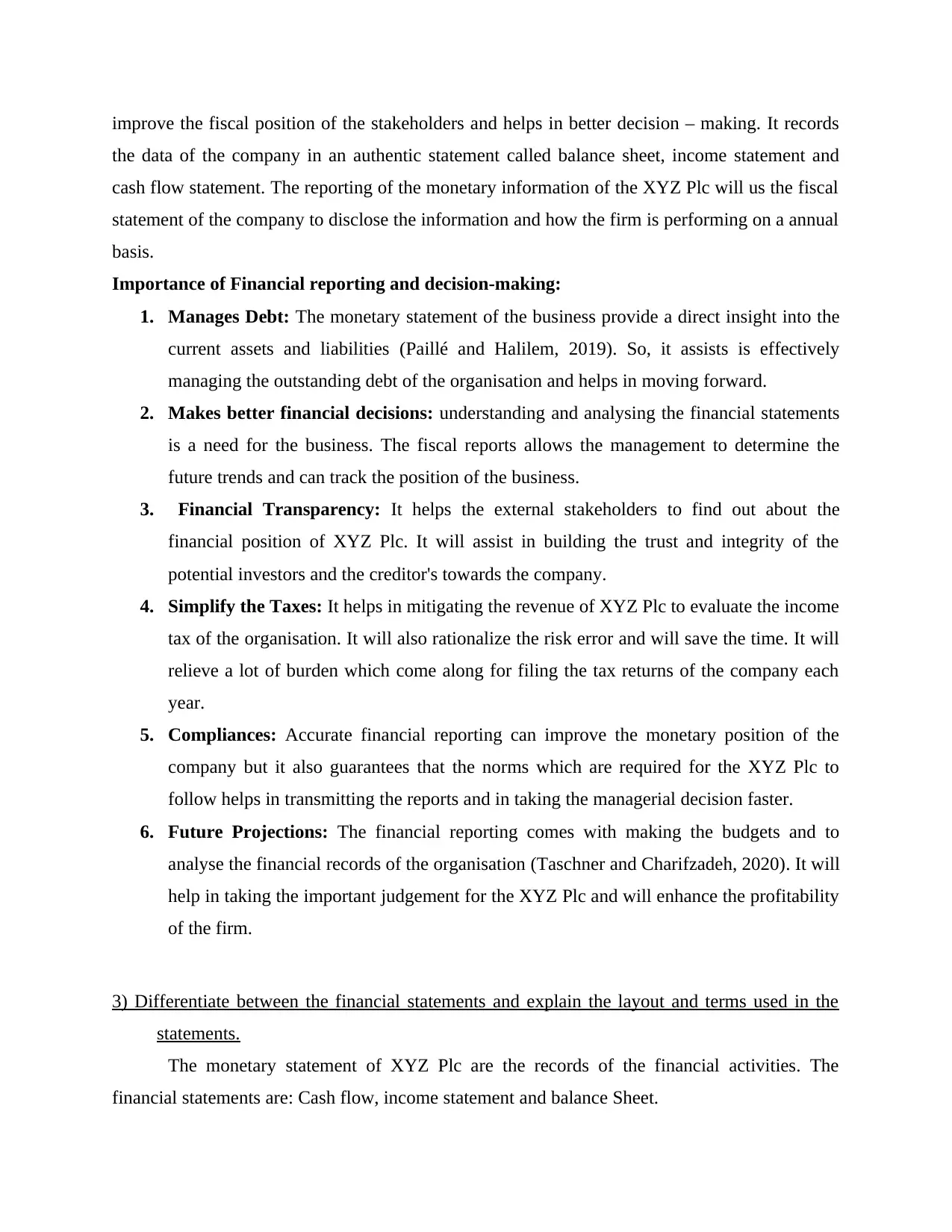
improve the fiscal position of the stakeholders and helps in better decision – making. It records
the data of the company in an authentic statement called balance sheet, income statement and
cash flow statement. The reporting of the monetary information of the XYZ Plc will us the fiscal
statement of the company to disclose the information and how the firm is performing on a annual
basis.
Importance of Financial reporting and decision-making:
1. Manages Debt: The monetary statement of the business provide a direct insight into the
current assets and liabilities (Paillé and Halilem, 2019). So, it assists is effectively
managing the outstanding debt of the organisation and helps in moving forward.
2. Makes better financial decisions: understanding and analysing the financial statements
is a need for the business. The fiscal reports allows the management to determine the
future trends and can track the position of the business.
3. Financial Transparency: It helps the external stakeholders to find out about the
financial position of XYZ Plc. It will assist in building the trust and integrity of the
potential investors and the creditor's towards the company.
4. Simplify the Taxes: It helps in mitigating the revenue of XYZ Plc to evaluate the income
tax of the organisation. It will also rationalize the risk error and will save the time. It will
relieve a lot of burden which come along for filing the tax returns of the company each
year.
5. Compliances: Accurate financial reporting can improve the monetary position of the
company but it also guarantees that the norms which are required for the XYZ Plc to
follow helps in transmitting the reports and in taking the managerial decision faster.
6. Future Projections: The financial reporting comes with making the budgets and to
analyse the financial records of the organisation (Taschner and Charifzadeh, 2020). It will
help in taking the important judgement for the XYZ Plc and will enhance the profitability
of the firm.
3) Differentiate between the financial statements and explain the layout and terms used in the
statements.
The monetary statement of XYZ Plc are the records of the financial activities. The
financial statements are: Cash flow, income statement and balance Sheet.
the data of the company in an authentic statement called balance sheet, income statement and
cash flow statement. The reporting of the monetary information of the XYZ Plc will us the fiscal
statement of the company to disclose the information and how the firm is performing on a annual
basis.
Importance of Financial reporting and decision-making:
1. Manages Debt: The monetary statement of the business provide a direct insight into the
current assets and liabilities (Paillé and Halilem, 2019). So, it assists is effectively
managing the outstanding debt of the organisation and helps in moving forward.
2. Makes better financial decisions: understanding and analysing the financial statements
is a need for the business. The fiscal reports allows the management to determine the
future trends and can track the position of the business.
3. Financial Transparency: It helps the external stakeholders to find out about the
financial position of XYZ Plc. It will assist in building the trust and integrity of the
potential investors and the creditor's towards the company.
4. Simplify the Taxes: It helps in mitigating the revenue of XYZ Plc to evaluate the income
tax of the organisation. It will also rationalize the risk error and will save the time. It will
relieve a lot of burden which come along for filing the tax returns of the company each
year.
5. Compliances: Accurate financial reporting can improve the monetary position of the
company but it also guarantees that the norms which are required for the XYZ Plc to
follow helps in transmitting the reports and in taking the managerial decision faster.
6. Future Projections: The financial reporting comes with making the budgets and to
analyse the financial records of the organisation (Taschner and Charifzadeh, 2020). It will
help in taking the important judgement for the XYZ Plc and will enhance the profitability
of the firm.
3) Differentiate between the financial statements and explain the layout and terms used in the
statements.
The monetary statement of XYZ Plc are the records of the financial activities. The
financial statements are: Cash flow, income statement and balance Sheet.
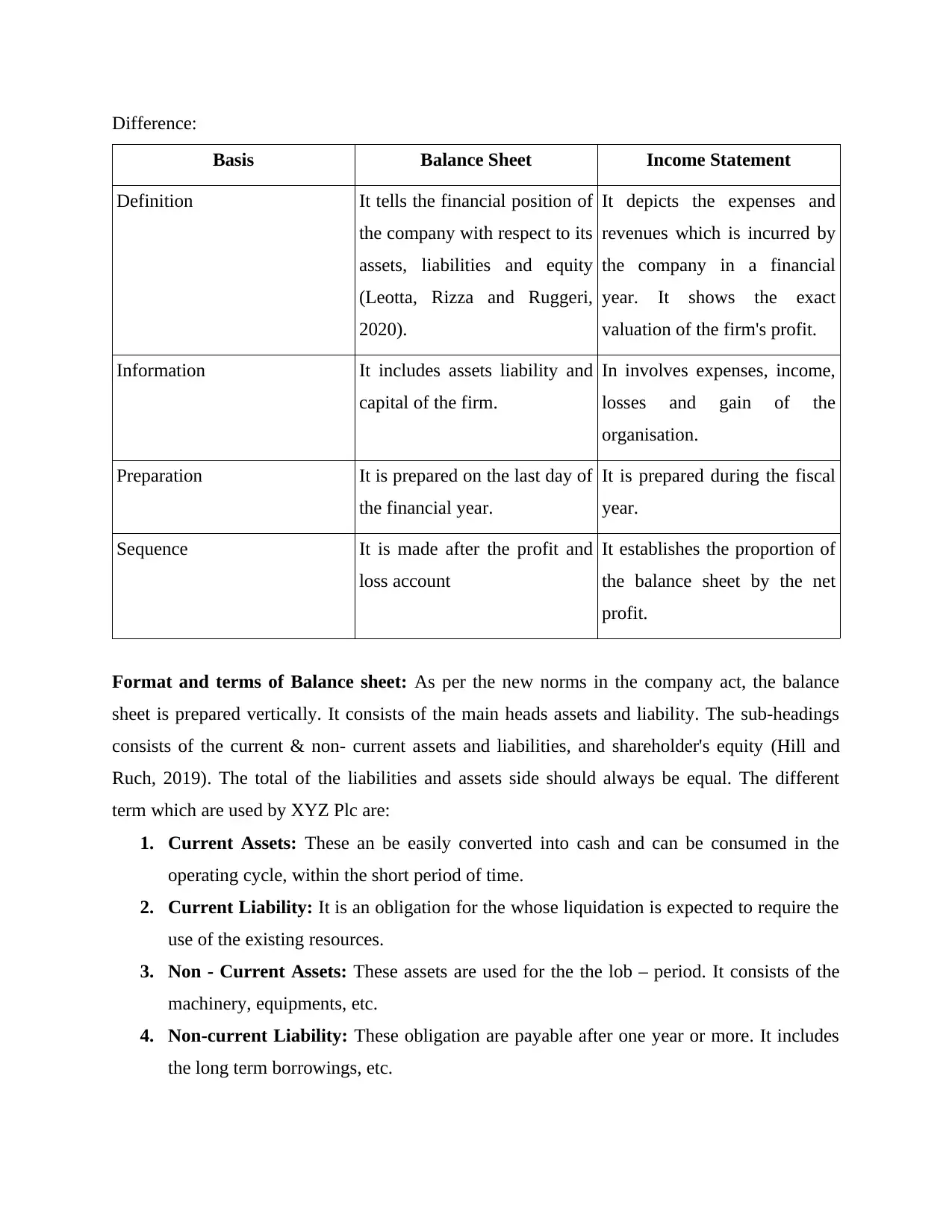
Difference:
Basis Balance Sheet Income Statement
Definition It tells the financial position of
the company with respect to its
assets, liabilities and equity
(Leotta, Rizza and Ruggeri,
2020).
It depicts the expenses and
revenues which is incurred by
the company in a financial
year. It shows the exact
valuation of the firm's profit.
Information It includes assets liability and
capital of the firm.
In involves expenses, income,
losses and gain of the
organisation.
Preparation It is prepared on the last day of
the financial year.
It is prepared during the fiscal
year.
Sequence It is made after the profit and
loss account
It establishes the proportion of
the balance sheet by the net
profit.
Format and terms of Balance sheet: As per the new norms in the company act, the balance
sheet is prepared vertically. It consists of the main heads assets and liability. The sub-headings
consists of the current & non- current assets and liabilities, and shareholder's equity (Hill and
Ruch, 2019). The total of the liabilities and assets side should always be equal. The different
term which are used by XYZ Plc are:
1. Current Assets: These an be easily converted into cash and can be consumed in the
operating cycle, within the short period of time.
2. Current Liability: It is an obligation for the whose liquidation is expected to require the
use of the existing resources.
3. Non - Current Assets: These assets are used for the the lob – period. It consists of the
machinery, equipments, etc.
4. Non-current Liability: These obligation are payable after one year or more. It includes
the long term borrowings, etc.
Basis Balance Sheet Income Statement
Definition It tells the financial position of
the company with respect to its
assets, liabilities and equity
(Leotta, Rizza and Ruggeri,
2020).
It depicts the expenses and
revenues which is incurred by
the company in a financial
year. It shows the exact
valuation of the firm's profit.
Information It includes assets liability and
capital of the firm.
In involves expenses, income,
losses and gain of the
organisation.
Preparation It is prepared on the last day of
the financial year.
It is prepared during the fiscal
year.
Sequence It is made after the profit and
loss account
It establishes the proportion of
the balance sheet by the net
profit.
Format and terms of Balance sheet: As per the new norms in the company act, the balance
sheet is prepared vertically. It consists of the main heads assets and liability. The sub-headings
consists of the current & non- current assets and liabilities, and shareholder's equity (Hill and
Ruch, 2019). The total of the liabilities and assets side should always be equal. The different
term which are used by XYZ Plc are:
1. Current Assets: These an be easily converted into cash and can be consumed in the
operating cycle, within the short period of time.
2. Current Liability: It is an obligation for the whose liquidation is expected to require the
use of the existing resources.
3. Non - Current Assets: These assets are used for the the lob – period. It consists of the
machinery, equipments, etc.
4. Non-current Liability: These obligation are payable after one year or more. It includes
the long term borrowings, etc.
⊘ This is a preview!⊘
Do you want full access?
Subscribe today to unlock all pages.

Trusted by 1+ million students worldwide
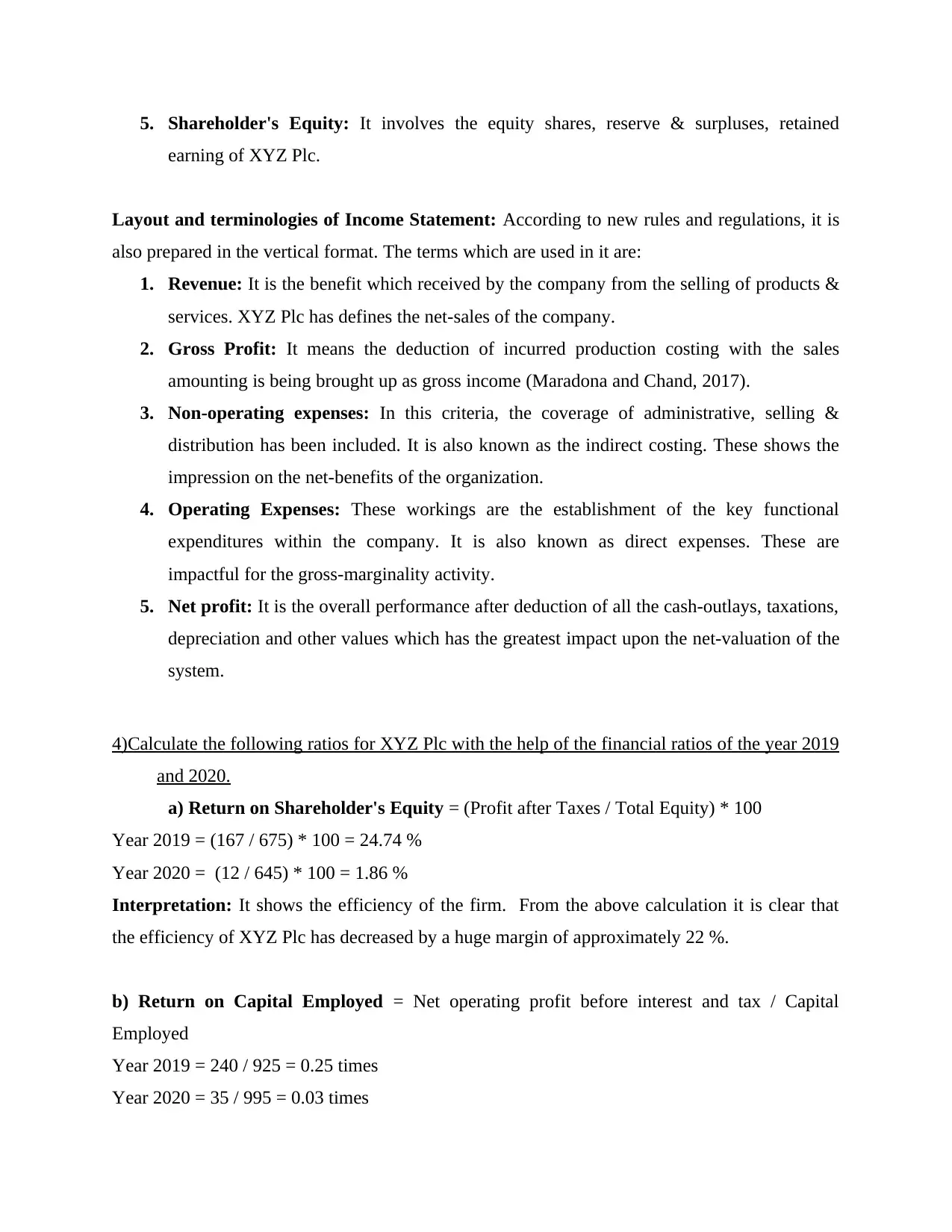
5. Shareholder's Equity: It involves the equity shares, reserve & surpluses, retained
earning of XYZ Plc.
Layout and terminologies of Income Statement: According to new rules and regulations, it is
also prepared in the vertical format. The terms which are used in it are:
1. Revenue: It is the benefit which received by the company from the selling of products &
services. XYZ Plc has defines the net-sales of the company.
2. Gross Profit: It means the deduction of incurred production costing with the sales
amounting is being brought up as gross income (Maradona and Chand, 2017).
3. Non-operating expenses: In this criteria, the coverage of administrative, selling &
distribution has been included. It is also known as the indirect costing. These shows the
impression on the net-benefits of the organization.
4. Operating Expenses: These workings are the establishment of the key functional
expenditures within the company. It is also known as direct expenses. These are
impactful for the gross-marginality activity.
5. Net profit: It is the overall performance after deduction of all the cash-outlays, taxations,
depreciation and other values which has the greatest impact upon the net-valuation of the
system.
4)Calculate the following ratios for XYZ Plc with the help of the financial ratios of the year 2019
and 2020.
a) Return on Shareholder's Equity = (Profit after Taxes / Total Equity) * 100
Year 2019 = (167 / 675) * 100 = 24.74 %
Year 2020 = (12 / 645) * 100 = 1.86 %
Interpretation: It shows the efficiency of the firm. From the above calculation it is clear that
the efficiency of XYZ Plc has decreased by a huge margin of approximately 22 %.
b) Return on Capital Employed = Net operating profit before interest and tax / Capital
Employed
Year 2019 = 240 / 925 = 0.25 times
Year 2020 = 35 / 995 = 0.03 times
earning of XYZ Plc.
Layout and terminologies of Income Statement: According to new rules and regulations, it is
also prepared in the vertical format. The terms which are used in it are:
1. Revenue: It is the benefit which received by the company from the selling of products &
services. XYZ Plc has defines the net-sales of the company.
2. Gross Profit: It means the deduction of incurred production costing with the sales
amounting is being brought up as gross income (Maradona and Chand, 2017).
3. Non-operating expenses: In this criteria, the coverage of administrative, selling &
distribution has been included. It is also known as the indirect costing. These shows the
impression on the net-benefits of the organization.
4. Operating Expenses: These workings are the establishment of the key functional
expenditures within the company. It is also known as direct expenses. These are
impactful for the gross-marginality activity.
5. Net profit: It is the overall performance after deduction of all the cash-outlays, taxations,
depreciation and other values which has the greatest impact upon the net-valuation of the
system.
4)Calculate the following ratios for XYZ Plc with the help of the financial ratios of the year 2019
and 2020.
a) Return on Shareholder's Equity = (Profit after Taxes / Total Equity) * 100
Year 2019 = (167 / 675) * 100 = 24.74 %
Year 2020 = (12 / 645) * 100 = 1.86 %
Interpretation: It shows the efficiency of the firm. From the above calculation it is clear that
the efficiency of XYZ Plc has decreased by a huge margin of approximately 22 %.
b) Return on Capital Employed = Net operating profit before interest and tax / Capital
Employed
Year 2019 = 240 / 925 = 0.25 times
Year 2020 = 35 / 995 = 0.03 times
Paraphrase This Document
Need a fresh take? Get an instant paraphrase of this document with our AI Paraphraser
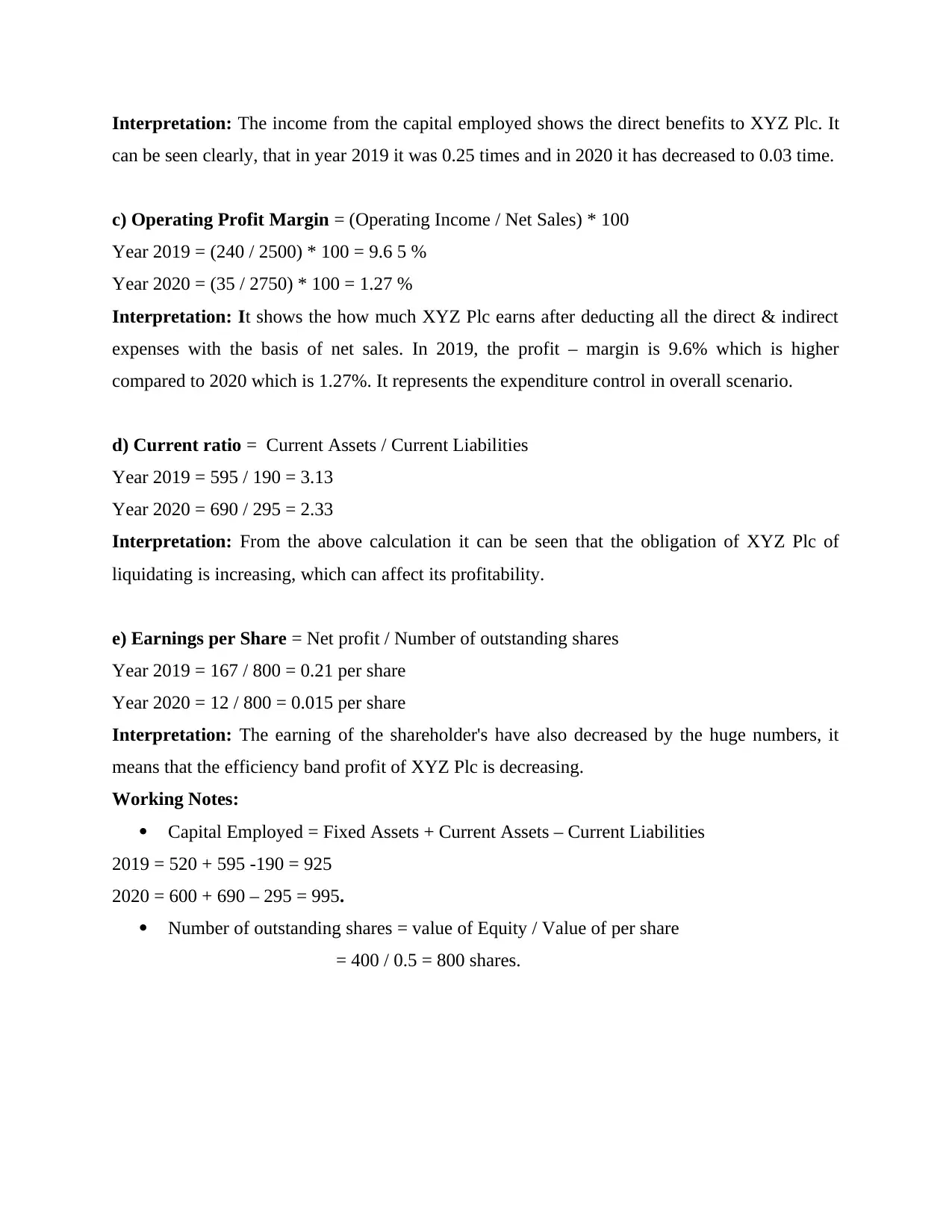
Interpretation: The income from the capital employed shows the direct benefits to XYZ Plc. It
can be seen clearly, that in year 2019 it was 0.25 times and in 2020 it has decreased to 0.03 time.
c) Operating Profit Margin = (Operating Income / Net Sales) * 100
Year 2019 = (240 / 2500) * 100 = 9.6 5 %
Year 2020 = (35 / 2750) * 100 = 1.27 %
Interpretation: It shows the how much XYZ Plc earns after deducting all the direct & indirect
expenses with the basis of net sales. In 2019, the profit – margin is 9.6% which is higher
compared to 2020 which is 1.27%. It represents the expenditure control in overall scenario.
d) Current ratio = Current Assets / Current Liabilities
Year 2019 = 595 / 190 = 3.13
Year 2020 = 690 / 295 = 2.33
Interpretation: From the above calculation it can be seen that the obligation of XYZ Plc of
liquidating is increasing, which can affect its profitability.
e) Earnings per Share = Net profit / Number of outstanding shares
Year 2019 = 167 / 800 = 0.21 per share
Year 2020 = 12 / 800 = 0.015 per share
Interpretation: The earning of the shareholder's have also decreased by the huge numbers, it
means that the efficiency band profit of XYZ Plc is decreasing.
Working Notes:
Capital Employed = Fixed Assets + Current Assets – Current Liabilities
2019 = 520 + 595 -190 = 925
2020 = 600 + 690 – 295 = 995.
Number of outstanding shares = value of Equity / Value of per share
= 400 / 0.5 = 800 shares.
can be seen clearly, that in year 2019 it was 0.25 times and in 2020 it has decreased to 0.03 time.
c) Operating Profit Margin = (Operating Income / Net Sales) * 100
Year 2019 = (240 / 2500) * 100 = 9.6 5 %
Year 2020 = (35 / 2750) * 100 = 1.27 %
Interpretation: It shows the how much XYZ Plc earns after deducting all the direct & indirect
expenses with the basis of net sales. In 2019, the profit – margin is 9.6% which is higher
compared to 2020 which is 1.27%. It represents the expenditure control in overall scenario.
d) Current ratio = Current Assets / Current Liabilities
Year 2019 = 595 / 190 = 3.13
Year 2020 = 690 / 295 = 2.33
Interpretation: From the above calculation it can be seen that the obligation of XYZ Plc of
liquidating is increasing, which can affect its profitability.
e) Earnings per Share = Net profit / Number of outstanding shares
Year 2019 = 167 / 800 = 0.21 per share
Year 2020 = 12 / 800 = 0.015 per share
Interpretation: The earning of the shareholder's have also decreased by the huge numbers, it
means that the efficiency band profit of XYZ Plc is decreasing.
Working Notes:
Capital Employed = Fixed Assets + Current Assets – Current Liabilities
2019 = 520 + 595 -190 = 925
2020 = 600 + 690 – 295 = 995.
Number of outstanding shares = value of Equity / Value of per share
= 400 / 0.5 = 800 shares.
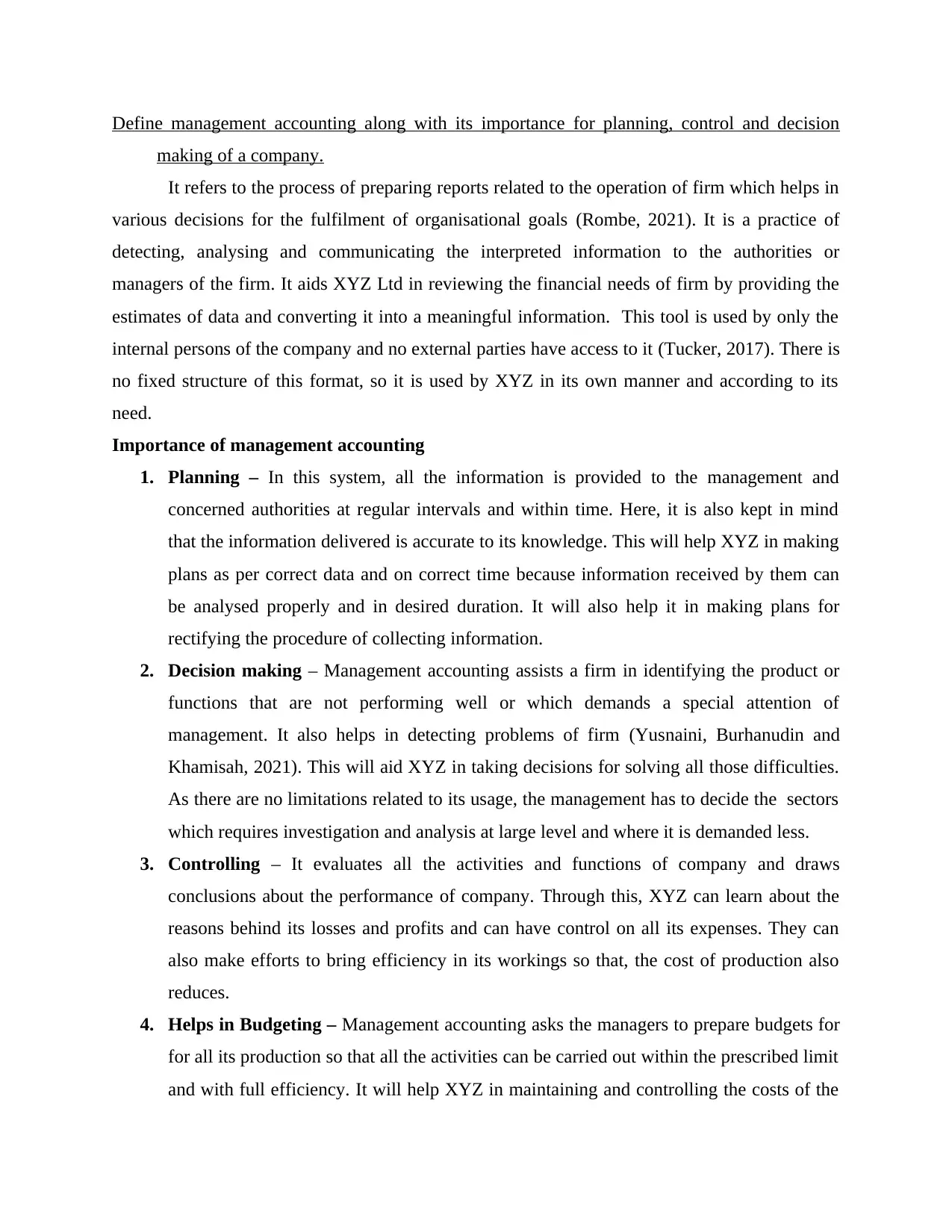
Define management accounting along with its importance for planning, control and decision
making of a company.
It refers to the process of preparing reports related to the operation of firm which helps in
various decisions for the fulfilment of organisational goals (Rombe, 2021). It is a practice of
detecting, analysing and communicating the interpreted information to the authorities or
managers of the firm. It aids XYZ Ltd in reviewing the financial needs of firm by providing the
estimates of data and converting it into a meaningful information. This tool is used by only the
internal persons of the company and no external parties have access to it (Tucker, 2017). There is
no fixed structure of this format, so it is used by XYZ in its own manner and according to its
need.
Importance of management accounting
1. Planning – In this system, all the information is provided to the management and
concerned authorities at regular intervals and within time. Here, it is also kept in mind
that the information delivered is accurate to its knowledge. This will help XYZ in making
plans as per correct data and on correct time because information received by them can
be analysed properly and in desired duration. It will also help it in making plans for
rectifying the procedure of collecting information.
2. Decision making – Management accounting assists a firm in identifying the product or
functions that are not performing well or which demands a special attention of
management. It also helps in detecting problems of firm (Yusnaini, Burhanudin and
Khamisah, 2021). This will aid XYZ in taking decisions for solving all those difficulties.
As there are no limitations related to its usage, the management has to decide the sectors
which requires investigation and analysis at large level and where it is demanded less.
3. Controlling – It evaluates all the activities and functions of company and draws
conclusions about the performance of company. Through this, XYZ can learn about the
reasons behind its losses and profits and can have control on all its expenses. They can
also make efforts to bring efficiency in its workings so that, the cost of production also
reduces.
4. Helps in Budgeting – Management accounting asks the managers to prepare budgets for
for all its production so that all the activities can be carried out within the prescribed limit
and with full efficiency. It will help XYZ in maintaining and controlling the costs of the
making of a company.
It refers to the process of preparing reports related to the operation of firm which helps in
various decisions for the fulfilment of organisational goals (Rombe, 2021). It is a practice of
detecting, analysing and communicating the interpreted information to the authorities or
managers of the firm. It aids XYZ Ltd in reviewing the financial needs of firm by providing the
estimates of data and converting it into a meaningful information. This tool is used by only the
internal persons of the company and no external parties have access to it (Tucker, 2017). There is
no fixed structure of this format, so it is used by XYZ in its own manner and according to its
need.
Importance of management accounting
1. Planning – In this system, all the information is provided to the management and
concerned authorities at regular intervals and within time. Here, it is also kept in mind
that the information delivered is accurate to its knowledge. This will help XYZ in making
plans as per correct data and on correct time because information received by them can
be analysed properly and in desired duration. It will also help it in making plans for
rectifying the procedure of collecting information.
2. Decision making – Management accounting assists a firm in identifying the product or
functions that are not performing well or which demands a special attention of
management. It also helps in detecting problems of firm (Yusnaini, Burhanudin and
Khamisah, 2021). This will aid XYZ in taking decisions for solving all those difficulties.
As there are no limitations related to its usage, the management has to decide the sectors
which requires investigation and analysis at large level and where it is demanded less.
3. Controlling – It evaluates all the activities and functions of company and draws
conclusions about the performance of company. Through this, XYZ can learn about the
reasons behind its losses and profits and can have control on all its expenses. They can
also make efforts to bring efficiency in its workings so that, the cost of production also
reduces.
4. Helps in Budgeting – Management accounting asks the managers to prepare budgets for
for all its production so that all the activities can be carried out within the prescribed limit
and with full efficiency. It will help XYZ in maintaining and controlling the costs of the
⊘ This is a preview!⊘
Do you want full access?
Subscribe today to unlock all pages.

Trusted by 1+ million students worldwide
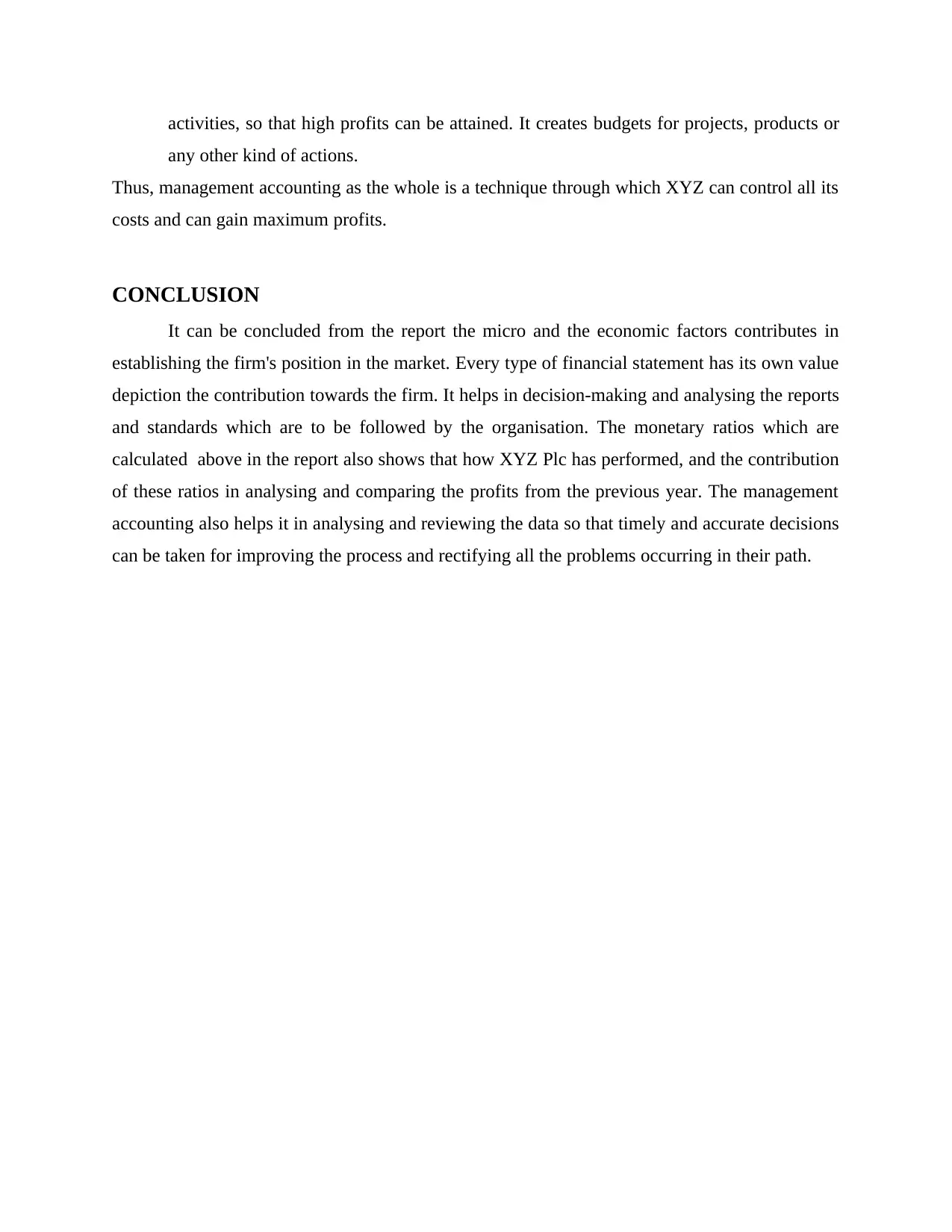
activities, so that high profits can be attained. It creates budgets for projects, products or
any other kind of actions.
Thus, management accounting as the whole is a technique through which XYZ can control all its
costs and can gain maximum profits.
CONCLUSION
It can be concluded from the report the micro and the economic factors contributes in
establishing the firm's position in the market. Every type of financial statement has its own value
depiction the contribution towards the firm. It helps in decision-making and analysing the reports
and standards which are to be followed by the organisation. The monetary ratios which are
calculated above in the report also shows that how XYZ Plc has performed, and the contribution
of these ratios in analysing and comparing the profits from the previous year. The management
accounting also helps it in analysing and reviewing the data so that timely and accurate decisions
can be taken for improving the process and rectifying all the problems occurring in their path.
any other kind of actions.
Thus, management accounting as the whole is a technique through which XYZ can control all its
costs and can gain maximum profits.
CONCLUSION
It can be concluded from the report the micro and the economic factors contributes in
establishing the firm's position in the market. Every type of financial statement has its own value
depiction the contribution towards the firm. It helps in decision-making and analysing the reports
and standards which are to be followed by the organisation. The monetary ratios which are
calculated above in the report also shows that how XYZ Plc has performed, and the contribution
of these ratios in analysing and comparing the profits from the previous year. The management
accounting also helps it in analysing and reviewing the data so that timely and accurate decisions
can be taken for improving the process and rectifying all the problems occurring in their path.
Paraphrase This Document
Need a fresh take? Get an instant paraphrase of this document with our AI Paraphraser
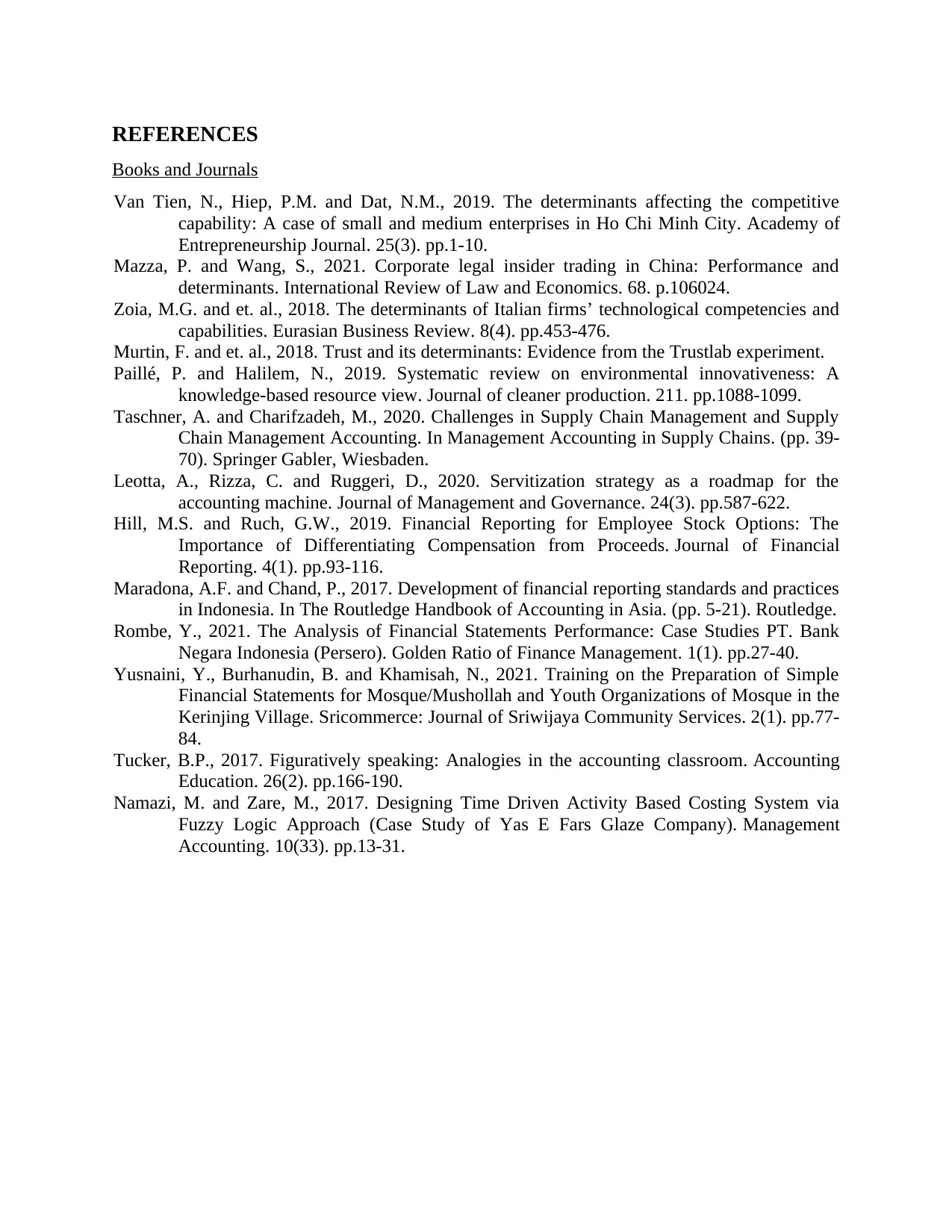
REFERENCES
Books and Journals
Van Tien, N., Hiep, P.M. and Dat, N.M., 2019. The determinants affecting the competitive
capability: A case of small and medium enterprises in Ho Chi Minh City. Academy of
Entrepreneurship Journal. 25(3). pp.1-10.
Mazza, P. and Wang, S., 2021. Corporate legal insider trading in China: Performance and
determinants. International Review of Law and Economics. 68. p.106024.
Zoia, M.G. and et. al., 2018. The determinants of Italian firms’ technological competencies and
capabilities. Eurasian Business Review. 8(4). pp.453-476.
Murtin, F. and et. al., 2018. Trust and its determinants: Evidence from the Trustlab experiment.
Paillé, P. and Halilem, N., 2019. Systematic review on environmental innovativeness: A
knowledge-based resource view. Journal of cleaner production. 211. pp.1088-1099.
Taschner, A. and Charifzadeh, M., 2020. Challenges in Supply Chain Management and Supply
Chain Management Accounting. In Management Accounting in Supply Chains. (pp. 39-
70). Springer Gabler, Wiesbaden.
Leotta, A., Rizza, C. and Ruggeri, D., 2020. Servitization strategy as a roadmap for the
accounting machine. Journal of Management and Governance. 24(3). pp.587-622.
Hill, M.S. and Ruch, G.W., 2019. Financial Reporting for Employee Stock Options: The
Importance of Differentiating Compensation from Proceeds. Journal of Financial
Reporting. 4(1). pp.93-116.
Maradona, A.F. and Chand, P., 2017. Development of financial reporting standards and practices
in Indonesia. In The Routledge Handbook of Accounting in Asia. (pp. 5-21). Routledge.
Rombe, Y., 2021. The Analysis of Financial Statements Performance: Case Studies PT. Bank
Negara Indonesia (Persero). Golden Ratio of Finance Management. 1(1). pp.27-40.
Yusnaini, Y., Burhanudin, B. and Khamisah, N., 2021. Training on the Preparation of Simple
Financial Statements for Mosque/Mushollah and Youth Organizations of Mosque in the
Kerinjing Village. Sricommerce: Journal of Sriwijaya Community Services. 2(1). pp.77-
84.
Tucker, B.P., 2017. Figuratively speaking: Analogies in the accounting classroom. Accounting
Education. 26(2). pp.166-190.
Namazi, M. and Zare, M., 2017. Designing Time Driven Activity Based Costing System via
Fuzzy Logic Approach (Case Study of Yas E Fars Glaze Company). Management
Accounting. 10(33). pp.13-31.
Books and Journals
Van Tien, N., Hiep, P.M. and Dat, N.M., 2019. The determinants affecting the competitive
capability: A case of small and medium enterprises in Ho Chi Minh City. Academy of
Entrepreneurship Journal. 25(3). pp.1-10.
Mazza, P. and Wang, S., 2021. Corporate legal insider trading in China: Performance and
determinants. International Review of Law and Economics. 68. p.106024.
Zoia, M.G. and et. al., 2018. The determinants of Italian firms’ technological competencies and
capabilities. Eurasian Business Review. 8(4). pp.453-476.
Murtin, F. and et. al., 2018. Trust and its determinants: Evidence from the Trustlab experiment.
Paillé, P. and Halilem, N., 2019. Systematic review on environmental innovativeness: A
knowledge-based resource view. Journal of cleaner production. 211. pp.1088-1099.
Taschner, A. and Charifzadeh, M., 2020. Challenges in Supply Chain Management and Supply
Chain Management Accounting. In Management Accounting in Supply Chains. (pp. 39-
70). Springer Gabler, Wiesbaden.
Leotta, A., Rizza, C. and Ruggeri, D., 2020. Servitization strategy as a roadmap for the
accounting machine. Journal of Management and Governance. 24(3). pp.587-622.
Hill, M.S. and Ruch, G.W., 2019. Financial Reporting for Employee Stock Options: The
Importance of Differentiating Compensation from Proceeds. Journal of Financial
Reporting. 4(1). pp.93-116.
Maradona, A.F. and Chand, P., 2017. Development of financial reporting standards and practices
in Indonesia. In The Routledge Handbook of Accounting in Asia. (pp. 5-21). Routledge.
Rombe, Y., 2021. The Analysis of Financial Statements Performance: Case Studies PT. Bank
Negara Indonesia (Persero). Golden Ratio of Finance Management. 1(1). pp.27-40.
Yusnaini, Y., Burhanudin, B. and Khamisah, N., 2021. Training on the Preparation of Simple
Financial Statements for Mosque/Mushollah and Youth Organizations of Mosque in the
Kerinjing Village. Sricommerce: Journal of Sriwijaya Community Services. 2(1). pp.77-
84.
Tucker, B.P., 2017. Figuratively speaking: Analogies in the accounting classroom. Accounting
Education. 26(2). pp.166-190.
Namazi, M. and Zare, M., 2017. Designing Time Driven Activity Based Costing System via
Fuzzy Logic Approach (Case Study of Yas E Fars Glaze Company). Management
Accounting. 10(33). pp.13-31.
1 out of 11
Related Documents
Your All-in-One AI-Powered Toolkit for Academic Success.
+13062052269
info@desklib.com
Available 24*7 on WhatsApp / Email
![[object Object]](/_next/static/media/star-bottom.7253800d.svg)
Unlock your academic potential
Copyright © 2020–2025 A2Z Services. All Rights Reserved. Developed and managed by ZUCOL.


